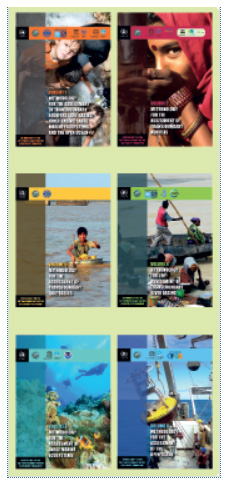A Transboundary Waters Assessment Programme: Aquifers, Lake/Reservoir Basins, River Basins, Large Marine Ecosystems, and Open Ocean to catalyze sound environmental management
Project objective: To undertake a global assessment of transboundary water bodies, through a formalised consortium of partners, to support informed investments by the GEF and other international organizations, and to be sustained through a periodic process in partnership with key institutions aiming at incorporating transboundary considerations into regular assessment programmes.
- - - - - - - - -
Recognizing the value of transboundary water systems and the fact that many of them continue to be degraded and managed in fragmented ways, the indicator-based Global Environment Facility Transboundary Waters Assessment Programme (GEF TWAP) was developed. The Programme aimed to provide a baseline assessment to identify and evaluate changes in these water systems caused by human activities and natural processes, and the consequences such have on dependent human populations.
At a first step, the methodologies for conducting a global assessment of the five types of transboundary water systems were developed during the TWAP Medium-sized Project (2009-2010). The TWAP Full-sized Project has implemented the first truly global comparative assessment for transboundary water system categories groundwater, lakes/reservoirs, rivers, large marine ecosystems); and a thematic evaluation of the open ocean, through institutional partnerships that hope to seed future global assessment as well. The project results assist the GEF and other international organizations in setting priorities for supporting the conservation of transboundary water systems.
How are the assessment conducted?
 The TWAP consists of five independent indicator-based assessment and the linkages between them, including their socioeconomic and governance-related features. The five water-category specific assessments cover 199 transboundary aquifers, 42 non-transboundary aquifers in small island developing states, 204 transboundary lakes and reservoirs, 286 transboundary river basins, 66 large marine ecosystems (and the Western Pacific Warm Pool), and the open ocean; a total of 756 international water systems. The assessed waters cover over 70% of the planet’s oceans and landmass, and about 16% of the planet’s landmass that is also underlain by transboundary aquifers. As a first global comparative assessment of transboundary waters (those shared by two or more countries), TWAP provides quantified assessment results that can inform the setting of priorities for intervention by GEF and others as well as the development of strategies on how nations and regions can meet their Sustainable Development Goals (SDGs) and targets by 2030.
The TWAP consists of five independent indicator-based assessment and the linkages between them, including their socioeconomic and governance-related features. The five water-category specific assessments cover 199 transboundary aquifers, 42 non-transboundary aquifers in small island developing states, 204 transboundary lakes and reservoirs, 286 transboundary river basins, 66 large marine ecosystems (and the Western Pacific Warm Pool), and the open ocean; a total of 756 international water systems. The assessed waters cover over 70% of the planet’s oceans and landmass, and about 16% of the planet’s landmass that is also underlain by transboundary aquifers. As a first global comparative assessment of transboundary waters (those shared by two or more countries), TWAP provides quantified assessment results that can inform the setting of priorities for intervention by GEF and others as well as the development of strategies on how nations and regions can meet their Sustainable Development Goals (SDGs) and targets by 2030.
The TWAP delivers the first baseline assessment of all the planet’s transboundary water resources, providing benchmarks of the current state of water systems to inform policy, encourage knowledge exchange, identify and classify water bodies at risk and increase awareness of the importance to protect transboundary waters at relatively low risk and mitigate the states of systems at moderate to highest risk. The TWAP assessment is the first global assessment that uses quantified indicators of system states, pressures and impacts under three broad themes: biophysical, socioeconomic, and governance. Results are summarized into five relative levels of system risk - lowest, low, moderate, high, and highest - which are amenable to system and regional scale comparisons. As such, TWAP is poised to help identify core indicators to support national monitoring and reporting of targets required to realize the Sustainable Development Goals for the period 2015 – 2030. TWAP freshwater indicators map to SDG 6 on Clean Water and Sanitation, notably Target 6.6 (protection and restoration of mountains, forests, wetlands, rivers, aquifers and lakes). TWAP marine indicators support SDG 14 on Oceans, Seas and Marine Resources, and all its targets.
The United Nations Environment (UNEP) is the implementing agency and the strategic partnerships formalized through the TWAP are shown in section Partners. Each partner engaged a broad network of experts that evaluate transboundary water systems thematically or geographically, and comparatively, within each water system category. They employed a range of tools in such efforts, including mathematical models and geographical information systems to examine basin states.
http://www.geftwap.org/
Global
| TDA/SAP |
|---|
| No items found... |
| Documents & Resources |
|---|
| General information | |
|---|---|
| GEF ID | 4489 |
| Project type | Full-Size Project |
| Status | closed (Project Approved) |
| Start Date | 19 Dec 2012 |
| End Date | 31 Jul 2016 |
| GEF characteristic: | |
|---|---|
| Focal Area | International Waters |
| GEF Allocation to project | 5,000,000 USD |
| Total Cost of the project: | 37,003,813.00 USD |
| Partners |
|---|
|
Global
UN Environment (UNEP) |
| Project contacts |
|---|
|
Ivan Zavadsky
Executive Secretary
Liana Talaue McManus
Project Manager
Isabelle Vanderbeck
GEF IW Task Manager (UNEP)
Joana Akrofi
Programme Officer
Kaisa Uusimaa
Associate Programme Officer
|

























